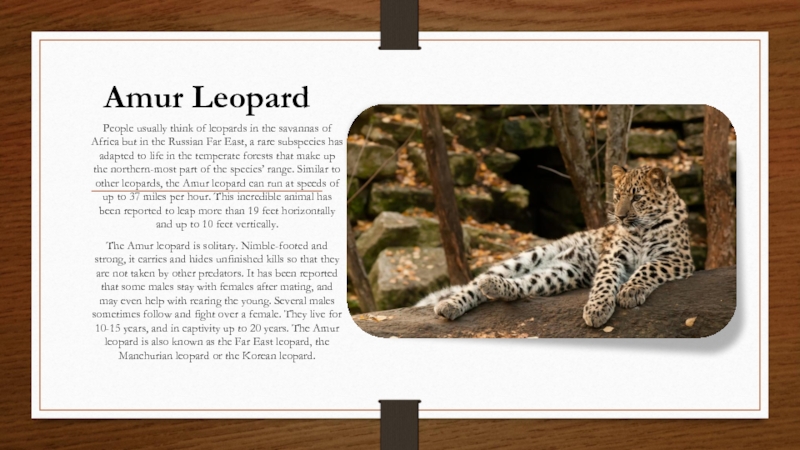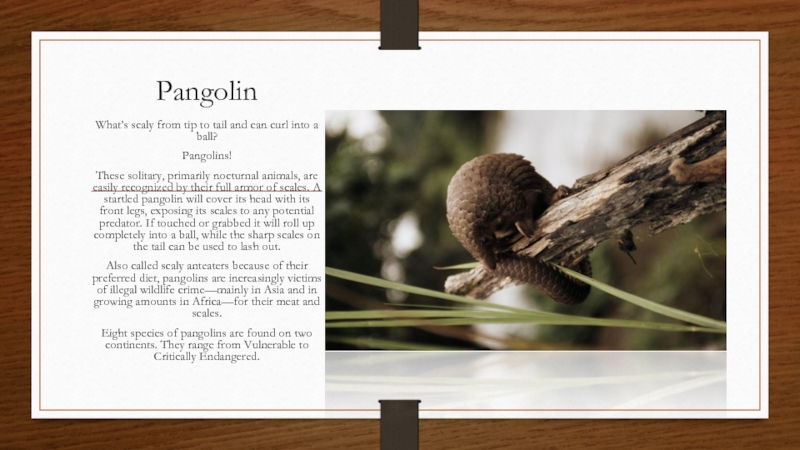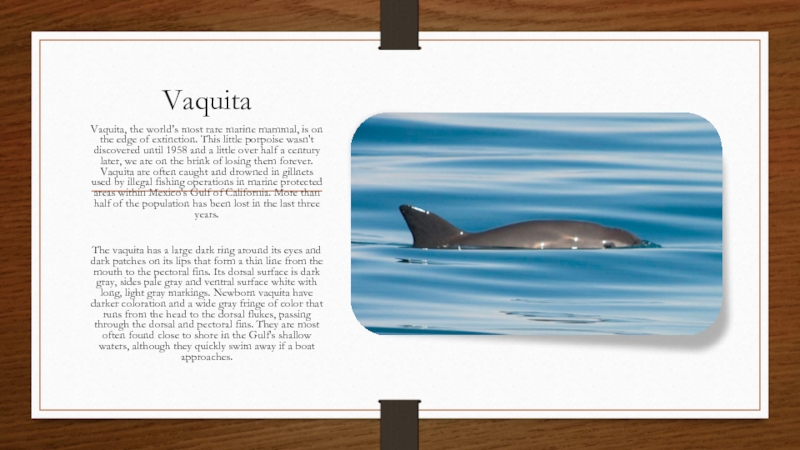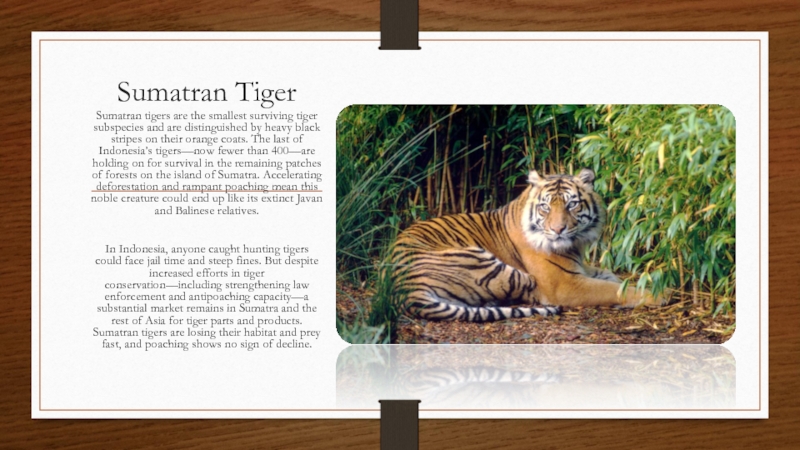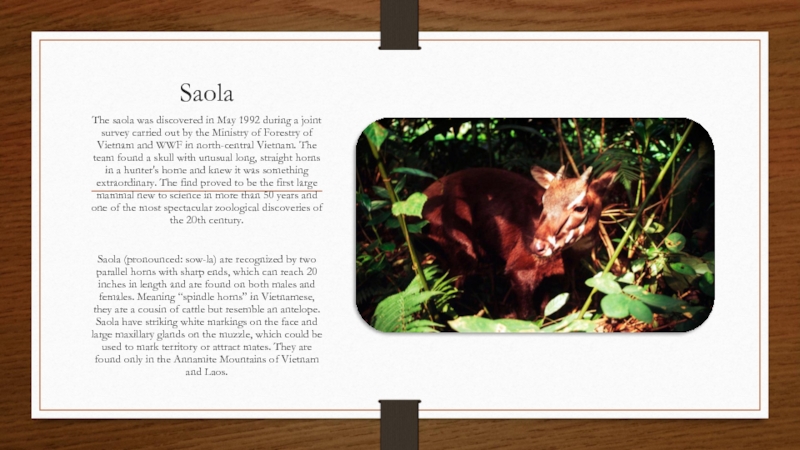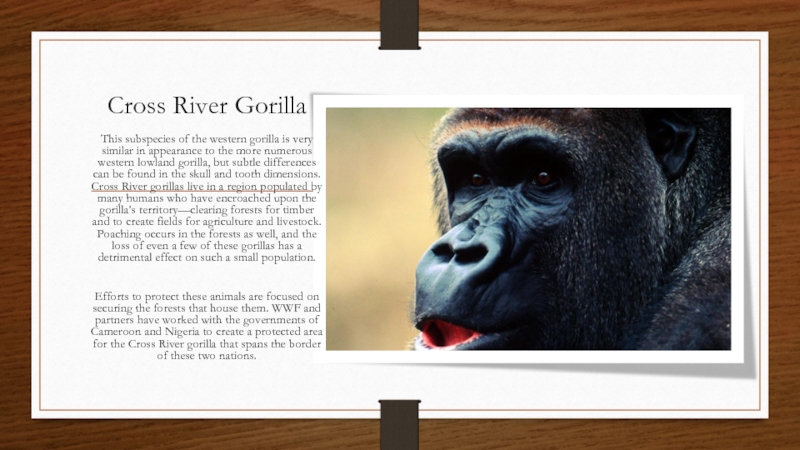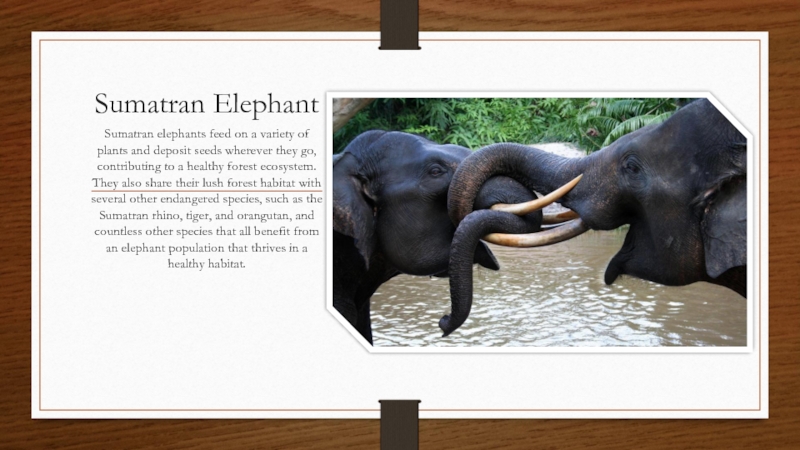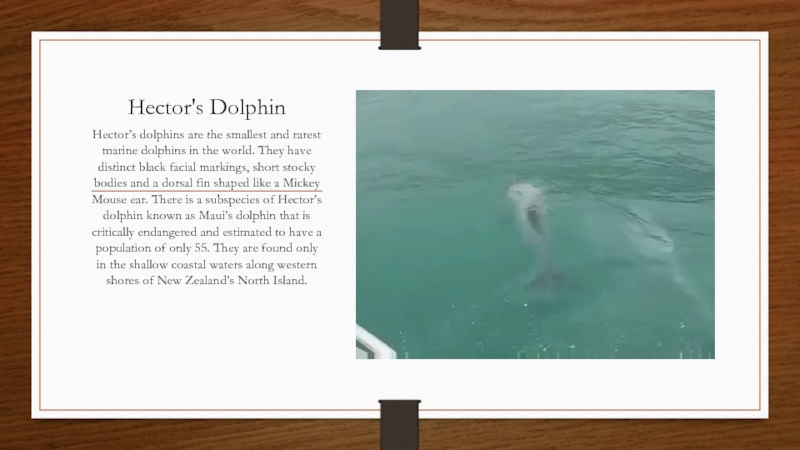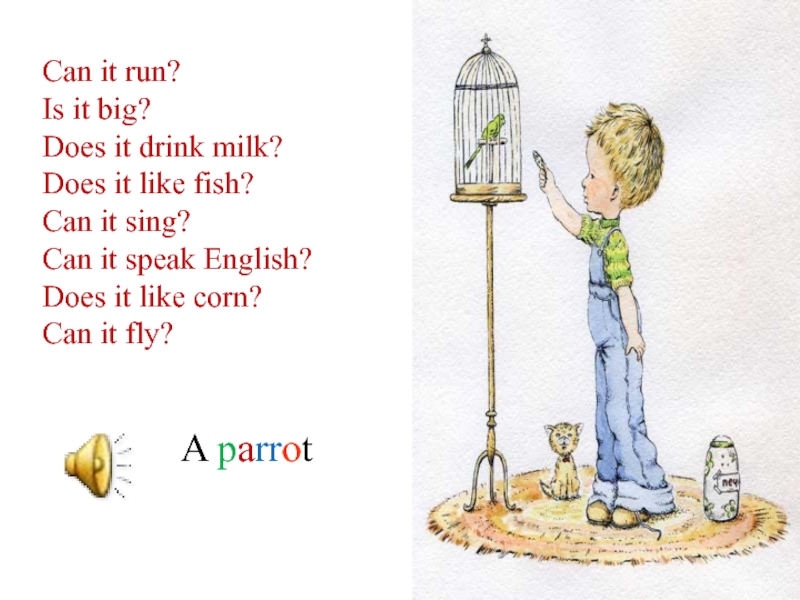Слайд 1The Most Endangered Species
Picking a Ten Most Endangered Animals list was
a tough job. For every critically endangered creature you select, you must leave out hundreds of other animals that are in just as much jeopardy.
That’s why, despite the video at the right, we chose not to include the giant panda on our roster of the world’s ten most endangered animals. The panda, as appealing and important as it is, has gotten plenty of attention from conservationists and the public alike. Time to make room for another critically endangered animal or two that hasn’t had as much time in the spotlight of looming extinction.
Endangered animals
Слайд 2Amur Leopard
People usually think of leopards in the savannas of Africa
but in the Russian Far East, a rare subspecies has adapted to life in the temperate forests that make up the northern-most part of the species’ range. Similar to other leopards, the Amur leopard can run at speeds of up to 37 miles per hour. This incredible animal has been reported to leap more than 19 feet horizontally and up to 10 feet vertically.
The Amur leopard is solitary. Nimble-footed and strong, it carries and hides unfinished kills so that they are not taken by other predators. It has been reported that some males stay with females after mating, and may even help with rearing the young. Several males sometimes follow and fight over a female. They live for 10-15 years, and in captivity up to 20 years. The Amur leopard is also known as the Far East leopard, the Manchurian leopard or the Korean leopard.
Слайд 3Pangolin
What’s scaly from tip to tail and can curl into a
ball?
Pangolins!
These solitary, primarily nocturnal animals, are easily recognized by their full armor of scales. A startled pangolin will cover its head with its front legs, exposing its scales to any potential predator. If touched or grabbed it will roll up completely into a ball, while the sharp scales on the tail can be used to lash out.
Also called scaly anteaters because of their preferred diet, pangolins are increasingly victims of illegal wildlife crime—mainly in Asia and in growing amounts in Africa—for their meat and scales.
Eight species of pangolins are found on two continents. They range from Vulnerable to Critically Endangered.
Слайд 4Vaquita
Vaquita, the world’s most rare marine mammal, is on the edge
of extinction. This little porpoise wasn't discovered until 1958 and a little over half a century later, we are on the brink of losing them forever. Vaquita are often caught and drowned in gillnets used by illegal fishing operations in marine protected areas within Mexico's Gulf of California. More than half of the population has been lost in the last three years.
The vaquita has a large dark ring around its eyes and dark patches on its lips that form a thin line from the mouth to the pectoral fins. Its dorsal surface is dark gray, sides pale gray and ventral surface white with long, light gray markings. Newborn vaquita have darker coloration and a wide gray fringe of color that runs from the head to the dorsal flukes, passing through the dorsal and pectoral fins. They are most often found close to shore in the Gulf's shallow waters, although they quickly swim away if a boat approaches.
Слайд 5Sumatran Tiger
Sumatran tigers are the smallest surviving tiger subspecies and are
distinguished by heavy black stripes on their orange coats. The last of Indonesia’s tigers—now fewer than 400—are holding on for survival in the remaining patches of forests on the island of Sumatra. Accelerating deforestation and rampant poaching mean this noble creature could end up like its extinct Javan and Balinese relatives.
In Indonesia, anyone caught hunting tigers could face jail time and steep fines. But despite increased efforts in tiger conservation—including strengthening law enforcement and antipoaching capacity—a substantial market remains in Sumatra and the rest of Asia for tiger parts and products. Sumatran tigers are losing their habitat and prey fast, and poaching shows no sign of decline.
Слайд 6Saola
The saola was discovered in May 1992 during a joint survey
carried out by the Ministry of Forestry of Vietnam and WWF in north-central Vietnam. The team found a skull with unusual long, straight horns in a hunter's home and knew it was something extraordinary. The find proved to be the first large mammal new to science in more than 50 years and one of the most spectacular zoological discoveries of the 20th century.
Saola (pronounced: sow-la) are recognized by two parallel horns with sharp ends, which can reach 20 inches in length and are found on both males and females. Meaning “spindle horns” in Vietnamese, they are a cousin of cattle but resemble an antelope. Saola have striking white markings on the face and large maxillary glands on the muzzle, which could be used to mark territory or attract mates. They are found only in the Annamite Mountains of Vietnam and Laos.
Слайд 7Green Turtle
The green turtle is one of the largest sea turtles
and the only herbivore among the different species. Green turtles are in fact named for the greenish color of their cartilage and fat, not their shells. In the Eastern Pacific, a group of green turtles that have darker shells are called black turtles by the local community. Green turtles are found mainly in tropical and subtropical waters. Like other sea turtles, they migrate long distances between feeding grounds and the beaches from where they hatched. Classified as endangered, green turtles are threatened by overharvesting of their eggs, hunting of adults, being caught in fishing gear and loss of nesting beach sites.
Слайд 8Cross River Gorilla
This subspecies of the western gorilla is very similar
in appearance to the more numerous western lowland gorilla, but subtle differences can be found in the skull and tooth dimensions. Cross River gorillas live in a region populated by many humans who have encroached upon the gorilla’s territory—clearing forests for timber and to create fields for agriculture and livestock. Poaching occurs in the forests as well, and the loss of even a few of these gorillas has a detrimental effect on such a small population.
Efforts to protect these animals are focused on securing the forests that house them. WWF and partners have worked with the governments of Cameroon and Nigeria to create a protected area for the Cross River gorilla that spans the border of these two nations.
Слайд 9Sumatran Elephant
Sumatran elephants feed on a variety of plants and deposit
seeds wherever they go, contributing to a healthy forest ecosystem. They also share their lush forest habitat with several other endangered species, such as the Sumatran rhino, tiger, and orangutan, and countless other species that all benefit from an elephant population that thrives in a healthy habitat.
Слайд 10Sumatran Rhino
Sumatran rhinos are the smallest of the living rhinoceroses and
the only Asian rhino with two horns. They are covered with long hair and are more closely related to the extinct woolly rhinos than any of the other rhino species alive today. Calves are born with a dense covering that turns reddish brown in young adults and becomes sparse, bristly and almost black in older animals. Sumatran rhinos compete with the Javan rhino for the unenviable title of most threatened rhino species. While surviving in greater numbers than the Javan rhino, Sumatran rhinos are more threatened by poaching. There is no indication that the population is stable and just two captive females have reproduced in the last 15 years.
The Sumatran rhino once roamed as far away as the foothills of the Eastern Himalayas in Bhutan and eastern India, through Myanmar, Thailand, possibly to Vietnam and China, and south through the Malay Peninsula. Two different subspecies, the western Sumatran and eastern Sumatran, cling for survival on the islands of Sumatra and Borneo. Experts believe the third subspecies is probably extinct.
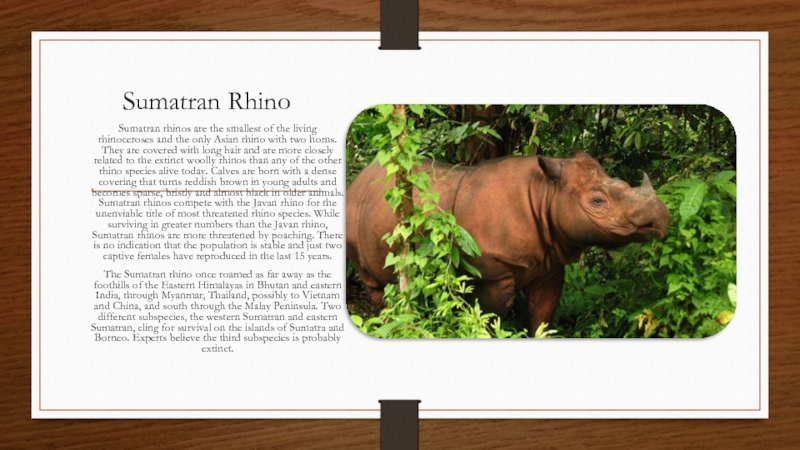
Слайд 11Hector's Dolphin
Hector’s dolphins are the smallest and rarest marine dolphins in
the world. They have distinct black facial markings, short stocky bodies and a dorsal fin shaped like a Mickey Mouse ear. There is a subspecies of Hector’s dolphin known as Maui’s dolphin that is critically endangered and estimated to have a population of only 55. They are found only in the shallow coastal waters along western shores of New Zealand’s North Island.

